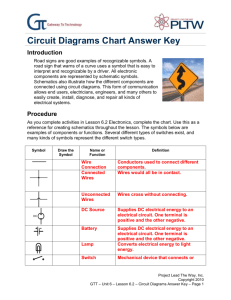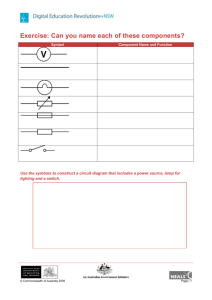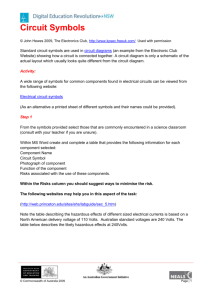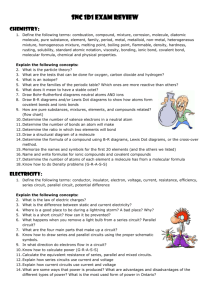Session A - Hamilton Trust
advertisement
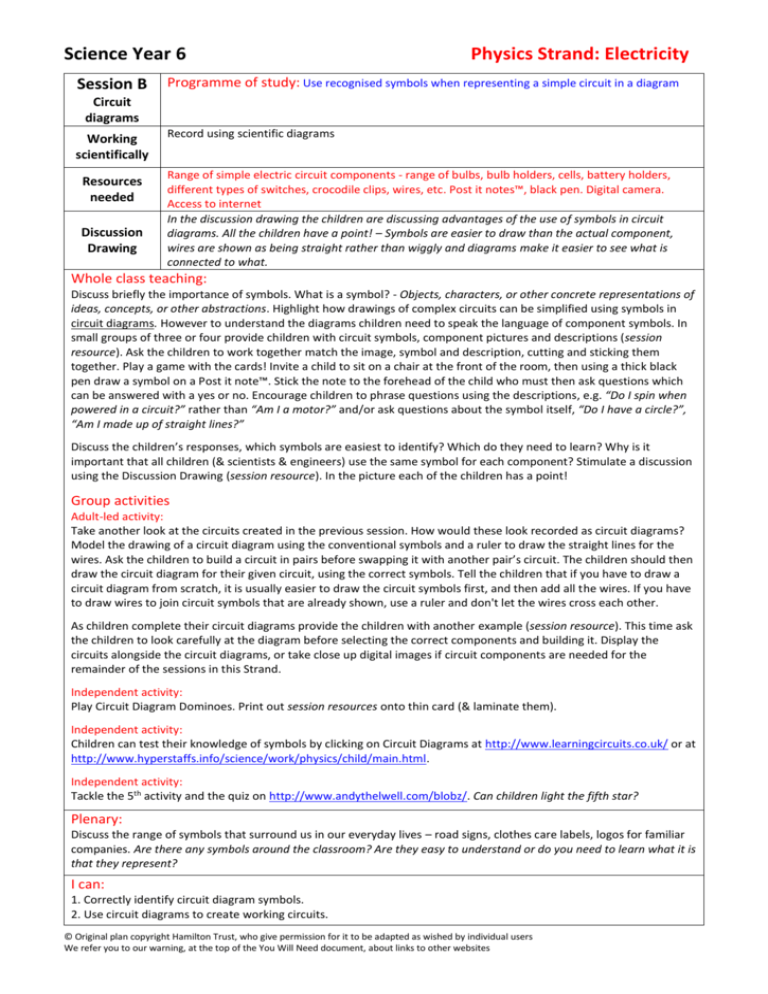
Science Year 6 Session B Physics Strand: Electricity Programme of study: Use recognised symbols when representing a simple circuit in a diagram Circuit diagrams Working scientifically Resources needed Discussion Drawing Record using scientific diagrams Range of simple electric circuit components - range of bulbs, bulb holders, cells, battery holders, different types of switches, crocodile clips, wires, etc. Post it notes™, black pen. Digital camera. Access to internet In the discussion drawing the children are discussing advantages of the use of symbols in circuit diagrams. All the children have a point! – Symbols are easier to draw than the actual component, wires are shown as being straight rather than wiggly and diagrams make it easier to see what is connected to what. Whole class teaching: Discuss briefly the importance of symbols. What is a symbol? - Objects, characters, or other concrete representations of ideas, concepts, or other abstractions. Highlight how drawings of complex circuits can be simplified using symbols in circuit diagrams. However to understand the diagrams children need to speak the language of component symbols. In small groups of three or four provide children with circuit symbols, component pictures and descriptions (session resource). Ask the children to work together match the image, symbol and description, cutting and sticking them together. Play a game with the cards! Invite a child to sit on a chair at the front of the room, then using a thick black pen draw a symbol on a Post it note™. Stick the note to the forehead of the child who must then ask questions which can be answered with a yes or no. Encourage children to phrase questions using the descriptions, e.g. “Do I spin when powered in a circuit?” rather than “Am I a motor?” and/or ask questions about the symbol itself, “Do I have a circle?”, “Am I made up of straight lines?” Discuss the children’s responses, which symbols are easiest to identify? Which do they need to learn? Why is it important that all children (& scientists & engineers) use the same symbol for each component? Stimulate a discussion using the Discussion Drawing (session resource). In the picture each of the children has a point! Group activities Adult-led activity: Take another look at the circuits created in the previous session. How would these look recorded as circuit diagrams? Model the drawing of a circuit diagram using the conventional symbols and a ruler to draw the straight lines for the wires. Ask the children to build a circuit in pairs before swapping it with another pair’s circuit. The children should then draw the circuit diagram for their given circuit, using the correct symbols. Tell the children that if you have to draw a circuit diagram from scratch, it is usually easier to draw the circuit symbols first, and then add all the wires. If you have to draw wires to join circuit symbols that are already shown, use a ruler and don't let the wires cross each other. As children complete their circuit diagrams provide the children with another example (session resource). This time ask the children to look carefully at the diagram before selecting the correct components and building it. Display the circuits alongside the circuit diagrams, or take close up digital images if circuit components are needed for the remainder of the sessions in this Strand. Independent activity: Play Circuit Diagram Dominoes. Print out session resources onto thin card (& laminate them). Independent activity: Children can test their knowledge of symbols by clicking on Circuit Diagrams at http://www.learningcircuits.co.uk/ or at http://www.hyperstaffs.info/science/work/physics/child/main.html. Independent activity: Tackle the 5th activity and the quiz on http://www.andythelwell.com/blobz/. Can children light the fifth star? Plenary: Discuss the range of symbols that surround us in our everyday lives – road signs, clothes care labels, logos for familiar companies. Are there any symbols around the classroom? Are they easy to understand or do you need to learn what it is that they represent? I can: 1. Correctly identify circuit diagram symbols. 2. Use circuit diagrams to create working circuits. © Original plan copyright Hamilton Trust, who give permission for it to be adapted as wished by individual users We refer you to our warning, at the top of the You Will Need document, about links to other websites
